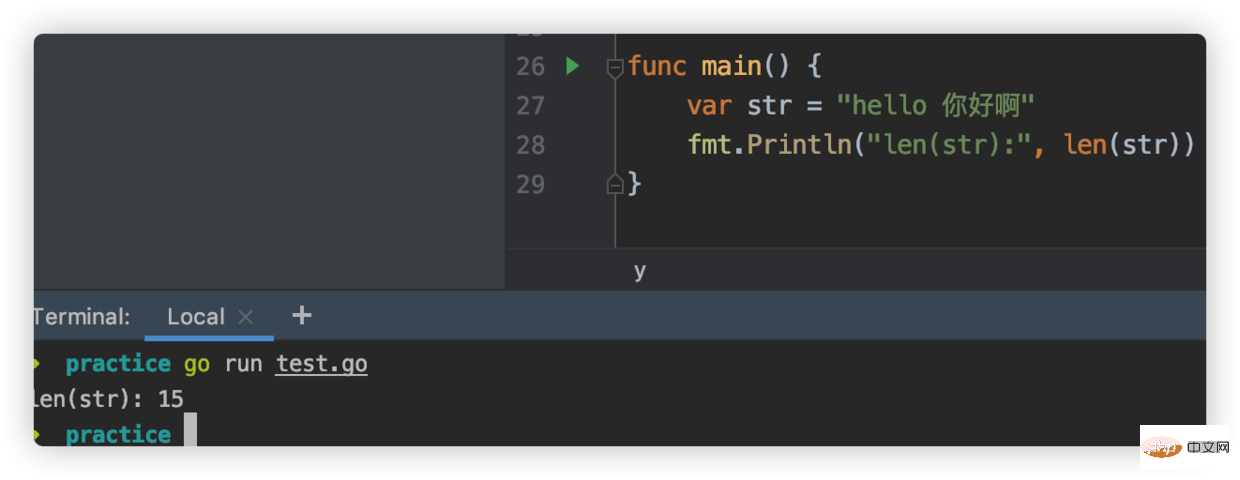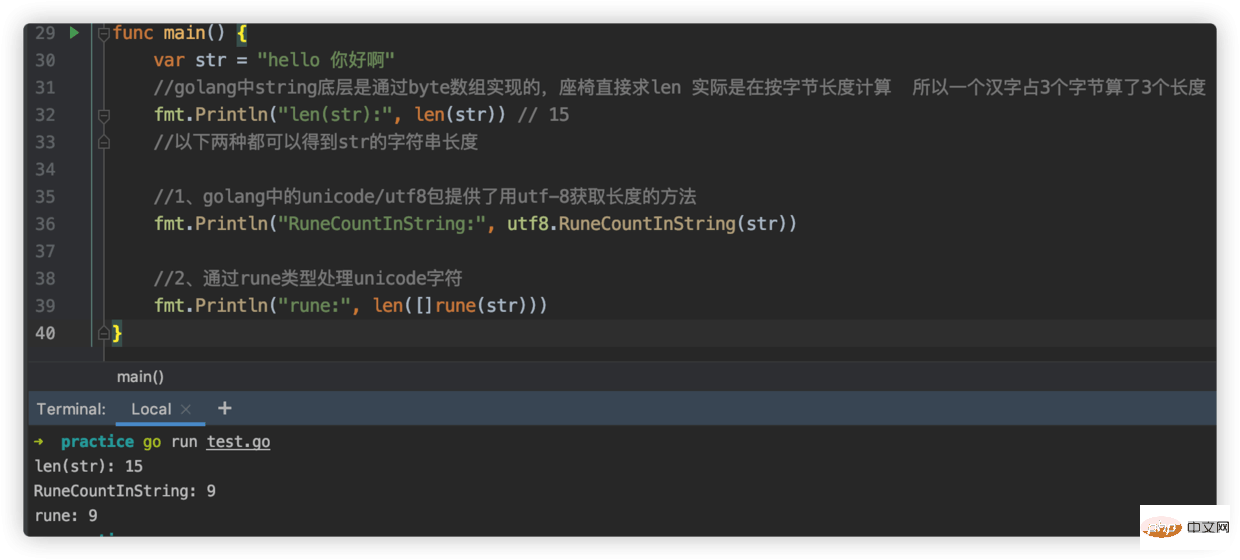How to get the character length of rune in go language
The following tutorial column from golang will introduce to you how to get the character length of rune in the go language. I hope it will be helpful to friends in need!

Rune is a special data type in the Go language. It is an alias of int32 and is equivalent to int32 in almost all aspects. It is used to distinguish character values and integer values. The official explanation is as follows:
// rune is an alias for int32 and is equivalent to int32 in all ways. It is // used, by convention, to distinguish character values from integer values. //int32的别名,几乎在所有方面等同于int32 //它用来区分字符值和整数值 type rune = int32
Let’s take a look at an example:
package mainimport "fmt"func main() {
var str = "hello 你好啊"
fmt.Println("len(str):", len(str))}Let’s guess the result, hello has 5 characters, 1 space, and 3 Chinese characters. It should be 9 in total, and the length is 9, but let’s execute it ,

The result printed is 15. Why is this?
The bottom layer of string in golang is implemented through byte array. Chinese characters occupy 2 bytes under unicode and 3 bytes under utf-8 encoding, and golang's default encoding is exactly utf-8.
So the calculated length is equal to 5 1 3*3=15
If we need to calculate the length of the string instead of the number of underlying bytes, we can use the following Method:
package main
import (
"fmt"
"unicode/utf8"
)
func main() {
var str = "hello 你好啊"
//golang中string底层是通过byte数组实现的,座椅直接求len 实际是在按字节长度计算 所以一个汉字占3个字节算了3个长度
fmt.Println("len(str):", len(str)) // 15
//以下两种都可以得到str的字符串长度
//1、golang中的unicode/utf8包提供了用utf-8获取长度的方法
fmt.Println("RuneCountInString:", utf8.RuneCountInString(str))
//2、通过rune类型处理unicode字符
fmt.Println("rune:", len([]rune(str)))
}The running result is as follows: 
There is another one above the rune definition, byte = uint8
// byte is an alias for uint8 and is equivalent to uint8 in all ways. It is // used, by convention, to distinguish byte values from 8-bit unsigned // integer values. type byte = uint8
- byte is equivalent to int8 , commonly used to process ascii characters
- rune is equivalent to int32, commonly used to process unicode or utf-8 characters
The above is the detailed content of How to get the character length of rune in go language. For more information, please follow other related articles on the PHP Chinese website!

Hot AI Tools

Undresser.AI Undress
AI-powered app for creating realistic nude photos

AI Clothes Remover
Online AI tool for removing clothes from photos.

Undress AI Tool
Undress images for free

Clothoff.io
AI clothes remover

Video Face Swap
Swap faces in any video effortlessly with our completely free AI face swap tool!

Hot Article

Hot Tools

Notepad++7.3.1
Easy-to-use and free code editor

SublimeText3 Chinese version
Chinese version, very easy to use

Zend Studio 13.0.1
Powerful PHP integrated development environment

Dreamweaver CS6
Visual web development tools

SublimeText3 Mac version
God-level code editing software (SublimeText3)

Hot Topics
 How to safely read and write files using Golang?
Jun 06, 2024 pm 05:14 PM
How to safely read and write files using Golang?
Jun 06, 2024 pm 05:14 PM
Reading and writing files safely in Go is crucial. Guidelines include: Checking file permissions Closing files using defer Validating file paths Using context timeouts Following these guidelines ensures the security of your data and the robustness of your application.
 How to configure connection pool for Golang database connection?
Jun 06, 2024 am 11:21 AM
How to configure connection pool for Golang database connection?
Jun 06, 2024 am 11:21 AM
How to configure connection pooling for Go database connections? Use the DB type in the database/sql package to create a database connection; set MaxOpenConns to control the maximum number of concurrent connections; set MaxIdleConns to set the maximum number of idle connections; set ConnMaxLifetime to control the maximum life cycle of the connection.
 How to save JSON data to database in Golang?
Jun 06, 2024 am 11:24 AM
How to save JSON data to database in Golang?
Jun 06, 2024 am 11:24 AM
JSON data can be saved into a MySQL database by using the gjson library or the json.Unmarshal function. The gjson library provides convenience methods to parse JSON fields, and the json.Unmarshal function requires a target type pointer to unmarshal JSON data. Both methods require preparing SQL statements and performing insert operations to persist the data into the database.
 Golang framework vs. Go framework: Comparison of internal architecture and external features
Jun 06, 2024 pm 12:37 PM
Golang framework vs. Go framework: Comparison of internal architecture and external features
Jun 06, 2024 pm 12:37 PM
The difference between the GoLang framework and the Go framework is reflected in the internal architecture and external features. The GoLang framework is based on the Go standard library and extends its functionality, while the Go framework consists of independent libraries to achieve specific purposes. The GoLang framework is more flexible and the Go framework is easier to use. The GoLang framework has a slight advantage in performance, and the Go framework is more scalable. Case: gin-gonic (Go framework) is used to build REST API, while Echo (GoLang framework) is used to build web applications.
 Transforming from front-end to back-end development, is it more promising to learn Java or Golang?
Apr 02, 2025 am 09:12 AM
Transforming from front-end to back-end development, is it more promising to learn Java or Golang?
Apr 02, 2025 am 09:12 AM
Backend learning path: The exploration journey from front-end to back-end As a back-end beginner who transforms from front-end development, you already have the foundation of nodejs,...
 How to find the first substring matched by a Golang regular expression?
Jun 06, 2024 am 10:51 AM
How to find the first substring matched by a Golang regular expression?
Jun 06, 2024 am 10:51 AM
The FindStringSubmatch function finds the first substring matched by a regular expression: the function returns a slice containing the matching substring, with the first element being the entire matched string and subsequent elements being individual substrings. Code example: regexp.FindStringSubmatch(text,pattern) returns a slice of matching substrings. Practical case: It can be used to match the domain name in the email address, for example: email:="user@example.com", pattern:=@([^\s]+)$ to get the domain name match[1].
 Golang framework development practical tutorial: FAQs
Jun 06, 2024 am 11:02 AM
Golang framework development practical tutorial: FAQs
Jun 06, 2024 am 11:02 AM
Go framework development FAQ: Framework selection: Depends on application requirements and developer preferences, such as Gin (API), Echo (extensible), Beego (ORM), Iris (performance). Installation and use: Use the gomod command to install, import the framework and use it. Database interaction: Use ORM libraries, such as gorm, to establish database connections and operations. Authentication and authorization: Use session management and authentication middleware such as gin-contrib/sessions. Practical case: Use the Gin framework to build a simple blog API that provides POST, GET and other functions.
 How to use predefined time zone with Golang?
Jun 06, 2024 pm 01:02 PM
How to use predefined time zone with Golang?
Jun 06, 2024 pm 01:02 PM
Using predefined time zones in Go includes the following steps: Import the "time" package. Load a specific time zone through the LoadLocation function. Use the loaded time zone in operations such as creating Time objects, parsing time strings, and performing date and time conversions. Compare dates using different time zones to illustrate the application of the predefined time zone feature.






